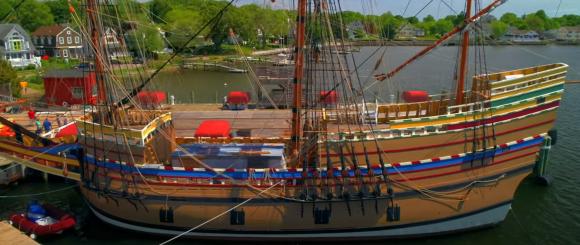 Today, Mayflower II, a replica of the ship that carried the Pilgrims to Plymouth, MA, was towed to New London, CT for two weeks of sea trials and final outfitting before returning to its homeport in Plymouth.
Today, Mayflower II, a replica of the ship that carried the Pilgrims to Plymouth, MA, was towed to New London, CT for two weeks of sea trials and final outfitting before returning to its homeport in Plymouth.
In September of last year, we posted about the launching of the Mayflower II at the Mystic Seaport Museum‘s Henry B. duPont Preservation Shipyard. The 64-year-old ship underwent a more than three-year $11 million restoration at the seaport shipyard.
The original plan was to begin moving the Mayflower II to Plymouth, MA with a departure in late April including several stops at southern New England ports before a May arrival. The plan was scrapped due to the pandemic. The Mayflower II is expected to arrive in Plymouth around August 10th.
Boston.com notes that the Mayflower II has been a major tourist attraction and educational tool since it arrived in Plymouth as a gift from England in 1957.
Stabilization efforts began in 2014, with the ship spending part of the year in Mystic. Continuous restoration work began at the seaport museum in 2016, with shipwrights from the seaport museum and artisans from Plimoth Plantation engaged in the work. The ship’s keel was saved, but nearly 75% of the vessel is reportedly new.

Not a replica. It is Bill Bakers reconstruction based on the information he had available, and the need to accommodate visitors. Today there might be design changes. Replica misleads.
The ship is referred to almost universally as a replica. Google “Mayflower II ” and count all the references to “replica.” Even the 1957 newsreels refer to her as a “replica.” I see no reason to redefine the common usage of the word. The definition in use today seems to reflect the following:
A ship replica is a reconstruction of a no longer existing ship. Replicas can range from authentically reconstructed, fully seaworthy ships, to ships of modern construction that give an impression of a historic vessel.
https://en.wikipedia.org/wiki/Ship_replica#:~:text=A%20ship%20replica%20is%20a,impression%20of%20a%20historic%20vessel.
And if it is not a replica, what is it? The museum refers to it as a “reproduction,” which is arguably worse than “replica.”